






I've been gardening and writing about gardening for more than 20 years, yet I find I'm always learning new things about the plants, insects and other critters that call my backyard home. That's the great thing about gardening — it's never boring! I've worked as a landscaper, on an organic farm, as a research technician in a plant pathology lab and ran a small cut-flower business, all of which inform my garden writing. A few years ago my husband and I purchased a beautiful old Victorian house and opened a pet-friendly B&B; I've spent the last few summers renovating garden beds and adding new ones. My husband once asked me when I'll be finished, to which I replied, "Never!" For me, gardening is a process, not a goal.
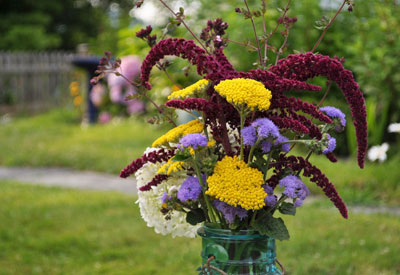
Freshly cut ageratum, amaranth, hydrangea, ornamental oregano and yarrow, ready to be dried. Photos: Suzanne DeJohn
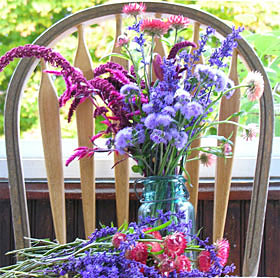
Flowers for drying
THE garden offers riches beyond the summer harvest of fresh vegetables, herbs and flowers — it's also the source of materials for variety of unique homemade gifts.
Giving a gift you've made yourself sends a message of caring to the recipient, and using homegrown materials makes it even more special. Summer is the time to gather and prepare flowers and herbs so you'll have plenty of gift-making materials.
A bouquet of dried flowers in a pretty vase is an easy gift. You can also use dried flowers adorn a grape vine wreath base. My favorite flowers to dry are tall ageratum, amaranth, celosia, hydrangea, lavender, ornamental oregano, salvia, strawflower and yarrow.
These flowers have strong stems and dry quickly. Just strip off the leaves, gather the stems into small bunches with rubber bands and hang them upside down in a warm, dry, dark place.
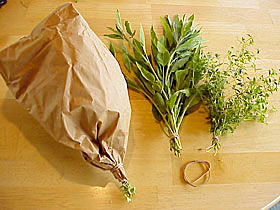
Herbs for drying
You can use dried herbs to create all sorts of "giftable" items, including culinary herb mixes, herb teas and potpourri. Dry herbs the same way you dry flowers — gather the stems into small bunches with rubber bands, and hang them upside down in a warm, dry, dark place. Cover them with a paper bag to keep the dust off. If humidity makes air-drying impossible, dry them in a warm oven or use a food dehydrator.
Following are a few ideas for transforming dried herbs into gifts. Package the herbs in an airtight container or plastic bag, listing the ingredients on a label. Include a recipe card with suggested uses.
Culinary herb blends:
Tea blends:
Good tea herbs include anise hyssop, chamomile, fennel, lavender, lemon balm, and mint. Add dried stevia for a touch of sweetness.
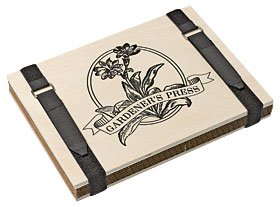
The absorbent blotting paper in the Flower Press promotes fast drying, which helps preserve flower color.
Potpourri:
Combine a selection of fragrant dried herbs, such as bay, lemon balm, lemon verbena, sage, rosemary, thyme, lavender, mint and scented geraniums. Add some flowers for color, such as borage, calendula, bachelor's buttons and rose petals. You can also add cinnamon sticks or dried citrus peels. Include a bottle of Essential Oil for refreshing the potpourri when the scent fades.
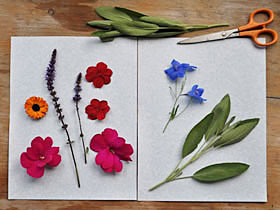
Pressing flowers and herbs
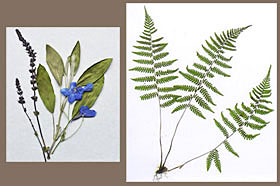
Pressed flower notecard, left, and fern for framing
Place fresh plant material between two sheets of paper, and then place something heavy over the paper — a few big gardening books, perhaps. Choose relatively flat plant material, such as leaves and ferns, as well as flowers that aren't too bulky — pansies, for example. Once they're pressed flat, you can use them right away or store them flat between sheets of paper.
Create a collage by tacking the leaves and flowers to a sheet of paper with small dabs of glue. You can frame the collage as is or photocopy it to make multiple notecards or framed prints. I've found that photocopied pressed flowers look very real and they won't dry out and fade like the real plant material does.
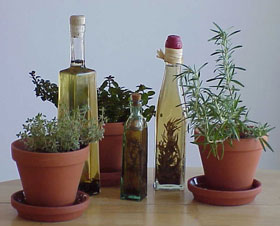
Herb vinegars
Making herbed vinegars couldn't be easier, and they make impressive gifts, especially if decanted into decorative bottles. Use your favorite culinary herbs and vinegars, or experiment with blends. Try pairing strong-flavored herbs like rosemary and sage with cider or red wine vinegar; use milder rice wine vinegar for more delicately flavored herbs like tarragon. Basil, cilantro, fennel, mint and thyme are all good candidates for herb vinegars; toss in a few chili peppers for heat or some strips of lemon or orange rind for a citrusy note. Adding a few chive flowers, nasturtium blossoms or purple basil leaves will add a nice tint to the vinegar.
1. Place the clean, dry herbs and other flavorings in a clean glass jar and then fill the jar with vinegar, making sure herbs are submerged. Shoot for a ratio of about a cup of fresh herbs for every two 2 cups of vinegar.
2. Put the lid on the jar and place it in a cool, dark place for about two weeks.
3. Pour the vinegar through cheesecloth and into a clean jar to remove the soggy herbs.
4. Store it in a big jar or decant it into pretty bottles and seal tightly. Although the vinegar's acidity acts as a preservative, to be on the safe side, it's a good idea to store the vinegar in the refrigerator and recommend the recipient do so as well.
Candles: Decorate candles with ferns, leaves, or flower petals. Melt some paraffin over a pan of water on low heat, watching carefully so it doesn't overheat. Use dabs of the melted wax to attach the leaves and petals to the candle, and then gently paint the wax over the entire surface of the plant material. Allow the wax to dry, then buff it with a cloth.
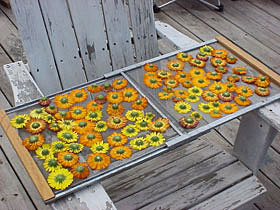
Drying calendula flowers on an old window screen
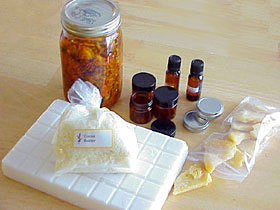
Calendula-infused oil, beeswax, bulk soap and essential oils
Soap: Making soap from scratch is an all-day endeavor and requires the use of caustic lye. An easier way is to purchase bulk glycerine or goat's milk soap (available at craft supplies stores) and some soap molds. Melt the soap and stir in some dried herbs and flower petals. For fragrance, add just a drop or two of Essential Oil (a little goes a long way!) Pour the mix into soap molds and let it cool and harden.
Soothing salve: Calendula flowers have anti-inflammatory properties and help promote healing. Place dried calendula flowers in a glass canning jar and cover with olive oil or sweet almond oil, making sure flowers are submerged. Cover and place in a warm spot for a few weeks. Then, strain the oil and discard the flowers. Combine 1 cup of the oil with 2 ounces beeswax and warm in a double boiler until the wax is just melted. (I keep a separate glass bowl for this project because the beeswax is difficult to remove by washing.) Pour into small tins or glass jars and allow to cool before covering. Label with the ingredients and suggest it for use on dry, cracked skin and rashes.
Copyright © www.100flowers.win Botanic Garden All Rights Reserved